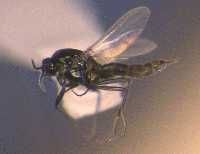|
The small flies, or gnats, are hatched in clean, running water.
This is one indicator our water protection plans are succeeding.
They will continue to hatch until water temperatures hit about
75 degrees. They will also travel up to 10 miles in search of a
food source, meaning blood.
 These
insects can produce serious welts when they decide to bite. They
tend to be worse during the day, and are seldom a problem inside
buildings. In addition to people, they tend to attack birds.
Young poultry and wild birds are especially vulnerable. Some
poultry insecticide treatments will help control the gnat
populations. These
insects can produce serious welts when they decide to bite. They
tend to be worse during the day, and are seldom a problem inside
buildings. In addition to people, they tend to attack birds.
Young poultry and wild birds are especially vulnerable. Some
poultry insecticide treatments will help control the gnat
populations.
Control is difficult. Sprays of malathion, permethrin, or
bifenthrin will help with controlling the buffalo gnats when
outdoor activities must be held in infested areas. Dusts of
permethrin will also help with outside poultry operations.
Repellents of DEET, citronella, vanilla, and some of the other
plant based repellents may also provide some relief. It seems
like the vanilla, or a commercial product such as Buggins or
black fly ointment, are most effective. Remember, only the
females bite and the males swarm your face. When the bite
occurs, a chemical is injected to help with blood flow. This is
often the reason for the painful welts, usually on the face.
Children also seem to be bitten, and affected, more than adults.
The gnats seem to be attracted to white clothing. Navy blue
seems to be the least favorite color of the buffalo gnat.
Tree Leaf Diseases

One of the normal scourges of spring has hit us again. This is
the group of fungi collectively known as leaf spot fungi. Common
ones include anthracnose and apple scab. Anthracnose starts as
dead leaf areas between leaf veins, or on the tips of leaves.
When severe enough, leaves will fall. Several of the infected
trees have actually had the leaves turn completely black
already. It is much more noticeable on one side of many trees as
well, due to air movement carrying the disease and drying out
foliage quickly.
[to top of second column] |

The good news is that it rarely harms trees. If enough leaves
drop, a new set comes out in 4-6 weeks and we start all over.
The next set of leaves may also get the disease, but they may
not. Infection can continue with weather favorable to the
disease, and when nighttime temperatures stay under 65 degrees.
Treatments when you see the symptoms of this disease are simply
wasted time and money.
Apple scab is a disease similar to anthracnose, and can cause
premature leaf drop in apples and crabapples. If you are on a
regular spray schedule for fruit trees, it should prevent most
of the problems. You could also spray crabapples this way, but
you would have to weigh the cost and benefit since no fruit
production is involved.
As a reminder, spray programs for disease prevention in fruit
trees should be applied every 10-14 days after the bloom period
is over. It should be stressed that these are preventative
programs, and not curative. These programs then continue until
roughly two weeks before the fruit is ready to harvest.
[By JOHN FULTON, COUNTY EXTENSION
DIRECTOR SERVING LOGAN, MENARD, AND SANGAMON COUNTIES]
 |